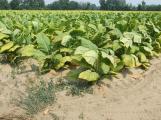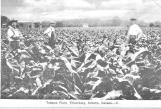14
Plants are nurtured along by cultivating and hoeing to remove any competition from weeds and grasses. Tobacco will establish a strong root system in the early stages of growth in the fields in drier conditions but require adequate moisture to develop into maturity. Irrigation is often required in the months of July and August when rainfall is not forthcoming.15
Another dangerous element in these warm summer months to the maturing plant is the green horn worm. These fastidious insects can consume a tobacco plant in a day's time; however, the farmer applied an application of insecticide using a high boy sprayer. In the 1950's to the 1970's, aerial spraying was also a popular method of applying insecticide to the fields of tobacco from low-flying airplanes. This took great flying skill as the aircraft was dropped only a few metres (feet) above the tobacco in order to spray the insecticide over the plants. This meant maneuvering the aircraft over buildings, power lines and woodlots.17
The Fields:Tobacco is grown on a every second year rotation with rye as cover crop: once ploughed down rye returns nitrate to the light sandy soil but on some farms with heavier soils wheat, corn and soybeans are grown in alternate years.
19
In the early years, horses were commonly used to plough and cultivating the fields for growing tobacco; Tractors quickly replaced the work horses as technology advanced.21
As tender seedlings, tobacco plants can be subjected to several detrimental insects, such as cutworm, wireworm, nematodes and seed maggots, which will destroy the young plants. As a preventive, appropriating chemicals are applied to the fields and the transplant water to control the insect population. The amount of tobacco grown was determined by the amount of rights that were assigned to each farm.22
Tobacco TopJuly 2008
Bothwell, Ontario, Canada
 Credits:
Credits:Courtesy of Bothwell-Zone & District Historical Society
23
Before Harvest:The tobacco plants send out a flowering bud in order to produce seed when it reaches maturity at the end of July to the early part of August. Topping is a very important step in producing tobacco as it determines the size and number of leaves. Suckers appear at the base of each leaf immediately after the topping of the plant which when left to grow will develop into a tall shoot competing for nutrients.




